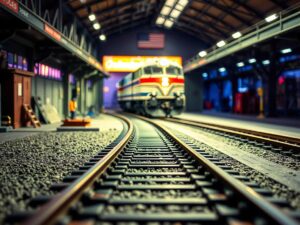
Designing a Realistic Suburban HO Scale Layout
Welcome to the world of miniature Americana! Today, we’re diving into the charm and intricacies of crafting a realistic suburban HO scale layout.
For those new to the hobby, let me break it down: “HO scale” simply means our model trains and accessories are miniatures scaled at 1:87, roughly 1/87th the size of their real-life counterparts. Suburban layouts are all about capturing the essence of daily life in residential areas â homes, parks, shops, streets â brought to a miniature wonderland.
Let’s embark on this journey together, learning the key steps and techniques to create your very own detailed suburban HO scale layout.
1. Conceptualization: The Blueprint of Your Vision
Before you fire up the soldering iron or paintbrush, envision what makes “your” ideal suburb.
- Location Inspiration: Draw inspiration from your hometown or dream communities. Is it a sprawling neighborhood with detached homes, quaint row houses, or perhaps a blend of modern townhouses and Victorian cottages?
- Railroad Theme: Decide on the era and style. Will it be a bustling post-WWII suburb, a sleek mid-century modern neighborhood, or a charming turn-of-the-century town? The chosen theme dictates your train types, infrastructure, and architectural details.
- Layout Size & Shape: Your space will dictate the overall dimensions. Measure carefully! Sketch out different layouts, considering track configurations (circular loops, switching yards) and how you can integrate scenery effectively. Don’t be afraid to get creative â your layout can even have levels and curves to enhance realism.
2. Planning & Design: Laying Down the Rails
Now that your vision is clear, let’s translate it into a physical blueprint.
- Track Planning Software: Programs like Anyrail or SCARM (available online) are invaluable. They allow you to virtually build your layout, experimenting with track layouts and ensure smooth train movements. Don’t forget to plan for turnout placement (allowing trains to switch tracks), sidings (small spurs for parked cars), and points of interest along the main line.
- Power & Control System: You’ll need a DC or DCC (Digital Command Control) system to power your layout. DCC allows for greater control over each locomotive, while DC is simpler but offers less advanced functionalities.
- Wiring Basics: A basic understanding of electrical circuits will be crucial. Use proper gauge wiring for safety and efficiency, and ensure you have reliable track connectors for seamless connections. Consider adding power boosters if you plan on running longer trains or multiple sections.
3. Construction: Bringing Your Plan to Life
The exciting part begins â constructing the physical foundation of your layout!
- Layering Technique: HO scale requires careful attention to depth and detail. Consider using layers for ground levels, streets, and structures to enhance realism. Begin with sturdy base material like plywood or foamboard, followed by track installation and additional layering.
- Ballasted Trackwork: This involves adding small ballast particles (stone or gravel) around the rails. This realistic effect fills gaps and creates a convincing transition between the tracks and surrounding scenery.
4. Scenery: Building Your Miniature World
Suburban HO scale layouts thrive on vibrant scenery, so let’s breathe life into your creation!
- Road Surfaces & Signage: Utilize various techniques to create detailed roads. Use asphalt or paving texture paints for a realistic finish, and add markings with specialized markers or decals. Don’t forget streetlights for a touch of ambiance!
- Landscaping Techniques:
- Hills and Terrains: Shape foamboard into desired forms, covering them with soil blends and layering ground cover materials.
- Water Features: Employ water effect mediums to create realistic ponds, streams, or even small waterfalls. Experiment with clear resin for captivating reflective surfaces.
- Trees & Vegetation: Miniature trees and foliage are available in vast arrays. Select sizes appropriate for your scale, paying attention to tree types that commonly grow in suburbs (e.g., oaks, maples, pines). Use static grass techniques or flocking to create lush lawns and grassy patches.
- Residential Details: This is where you capture the essence of suburban living!
- Kitbashing: Modify existing house kits or parts to create unique designs, reflecting diverse architectural styles found in your imagined suburb.
- Painting & Finishing: Invest in good quality acrylic paints and detail them with weathering techniques for a worn-in look.
5. Finishing Touches: Adding Life to Your Layout
The final touches truly bring your suburban HO scale layout to life!
- Figures & Vehicles: Add people going about their daily activities â mowing lawns, playing frisbee, or strolling on sidewalks. Include miniature cars parked along streets for added realism.
- Lighting: Utilize LED lighting strategically for illuminating homes, street lamps, and signs, adding a magical glow to your model town at night.
- Sound & Atmosphere: Incorporate realistic soundscapes through hidden sound modules â birds chirping, distant traffic, or even the gentle click of trains on rails can enhance immersion.
Insights for Aspiring Suburban HO Scalers:
- Embrace Modular Design: Building in modular sections makes your layout more flexible and allows you to expand or change its configuration as your skills and preferences evolve.
- Don’t Rush, Enjoy the Journey! Model railroading is a hobby best savored slowly. Experiment, learn from each project, and don’t be afraid to try new techniques. Most importantly, have fun building your miniature world!
We hope this guide has ignited your imagination and provided you with the essential tools to design your own captivating suburban HO scale layout. Join us in the online model railroading community for tips, inspiration, and a supportive network of fellow enthusiasts.







